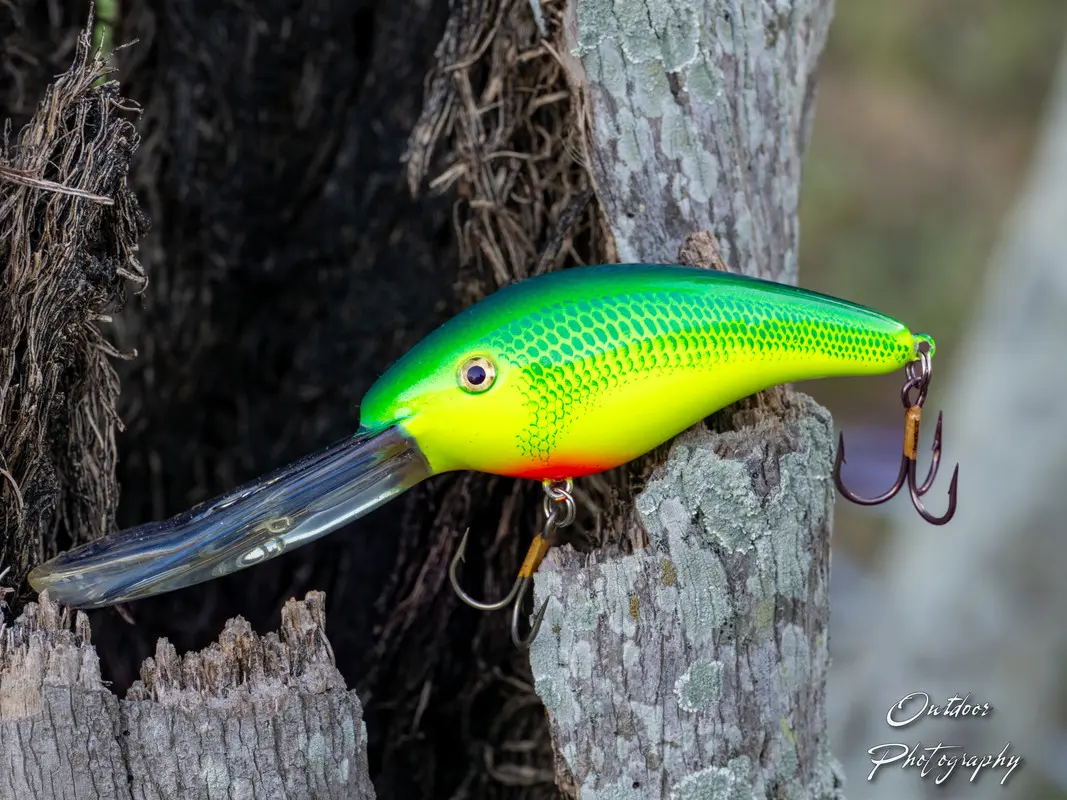Tackle: Lure - Crankbaits (Deep Diving)

Deep Diving Crankbaits: Gear, Line, Rod & Reel Setup Guide
Deep-diving crankbaits are essential tools for reaching suspended or structure-holding bass in deep water. Whether dredging ledges or bouncing off offshore humps, the right tackle setup is as important as the lure itself.
🎣 Rod Length, Action & Construction
- Length: Most experts recommend a rod between 7′‑6″ and 8'. Longer rods allow longer casts, which translates directly into deeper lure action.
- Power/Action: A medium‑heavy (MH) rod with moderate or moderate‑fast action is ideal. This offers enough backbone for the lure and hooking power, while the moderate-tip provides a smoother bend to avoid premature hook pull-outs.
- Construction: A rod with about 90% fiberglass blended with graphite gives a parabolic bend—less tip stiffness, more load distribution for casting and hooking deep divers.
♻️ Reel Gear Ratio
- A 5.1:1 gear ratio baitcasting reel is widely preferred for deep divers. This lower-speed reel offers high torque for fighting fish and lets the bait stay in zone longer during retrieve. .
- While some anglers run 5.4:1 or even 6.1:1 for smaller or mid-range cranks, deep-diving crankbaits—especially large ones—are best matched to 5:1 to maximize power and control.
🧵 Line Choice & Tests
- Fluorocarbon in the 10 lb test range is the top choice for most deep-cranking scenarios. It sinks and has low stretch—helping the lure run as deep as possible and increases the hookup ratio.
- Many tournament anglers recommend **10 lb fluorocarbon as standard.
- For ultra-heavy magnum deep divers like the Strike King 10XD, a minimum of 12 lb fluoro is advised—to avoid line breakage during heavy casts.
🎯 Recommended Tackle Summary
| Component | Preferred Setup |
|---|---|
| Rod | 7′‑6″ to 8' Medium‑Heavy, moderate action, mostly fiberglass |
| Reel | Baitcasting reel, 5.1:1 ratio |
| Line | 10 lb fluorocarbon standard; ≥12 lb fluoro for large magnum divers like 10XD |
| Knot | Reliable uni knot or Palomar |
🐟 3 Situations Where Deep Divers Excel
-
Offshore Ledges & Points
When bass suspend along 20–30 ft ledges, a deep-diving crankbait like the Strike King 10XD or Rapala DT‑20 lets you sweep the depth zone efficiently and provoke reaction strikes. -
Over Brush Piles in Deep Flats
On brush-laden structure in 15–25 ft range, deep divers performed near wood piles bounce the lure erratically—triggering strikes from wary fish. -
When Water Clarity & Light Are Low
In stained water or cloudy conditions where visibility is down, the aggressive thump and profile of a deep diver help fish locate and chase the bait.
📋 Top 5 Deep‑Diving Crankbaits: Length / Weight / Dive Depth
| Brand & Model | Length | Weight | Nominal Diving Depth |
|---|---|---|---|
| Strike King 10XD | 6″ | ~2 oz | 23–25 ft (up to 30 ft) |
| Rapala DT Metal 20 | ~2¾″ | ~7/8 oz | ~20 ft |
| SPRO Little John Deep Diver | ~4¼″ | ~1 oz | ~12–15 ft |
| Mann’s 30+ Deep Diver | ~4¼″ | ~¾–1 oz | ~25 ft |
| Berkley Dredger | ~4–5″ | ~¾–1 oz | ~15–20 ft |
(Depths vary with line diameter, casting, retrieve speed, and conditions.)
The World's Most Complete Fishing Resource
We're building the ultimate fishing encyclopedia—created by anglers, for anglers. Our articles are created by real experienced fishermen, sometimes using AI-powered research. This helps us try to cover every species, technique, and fishing spot imaginable. While we strive for accuracy, fishing conditions and regulations can change, and some details may become outdated or contain unintentional inaccuracies. AI can sometimes make mistakes with specific details like local access points, parking areas, species distributions, or record sizes.
Spot something off? Whether it's an incorrect boat ramp location, wrong species information, outdated regulations, or any other error, please use the "Help Us Improve This Page" section below. Your local knowledge makes this resource better for every angler.
Explore Related Topics
Discover more articles to deepen your knowledge
Curating articles for you...
Create your own Research Page using AI
Try our AI assistant for free—sign up to access this powerful feature